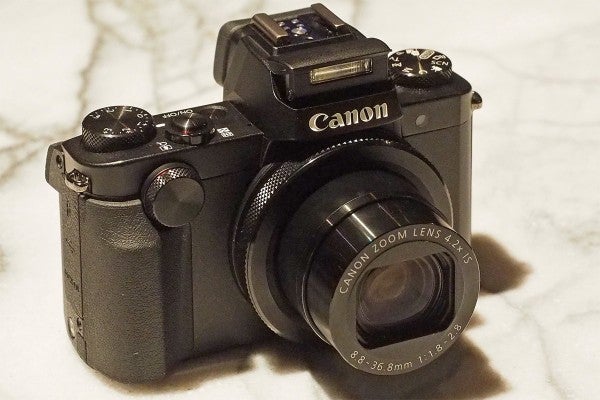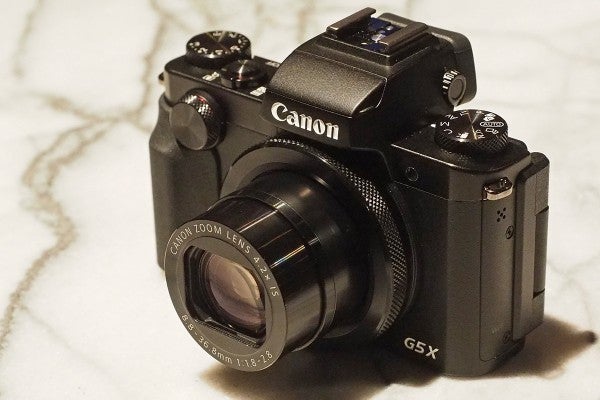Andy Westlake gets hands-on with Canon’s latest zoom compact for enthusiasts, the Canon PowerShot G5 X
Canon PowerShot G5 X – Hands-on First Look
http://link.brightcove.com/services/player/?bctid=4545757264001
Canon PowerShot G5 X – Hands-on First Look
At a glance:
- 20.2-million-pixel 1in sensor
- 24-100mm equivalent f/1.8-2.8 lens
- Optical image stabilization
- ISO 125-12800
- Shutter speeds 30-1/2000 sec + bulb
- 2.36-million-dot OLED EVF; 120 fps refresh
- 3-in 1.04-million-dot fully articulated touchscreen
- 5.9 fps continuous shooting; 4.4 fps with AF
- £629.99

The G5 X’s built-in flash pops up from the front of the viewfinder housing, below the hot shoe
It’s little over a year since we saw Canon’s first compact camera with a 1in sensor, the PowerShot G7 X. With its pocket-sized body and fast zoom lens, this was clearly designed to be a direct competitor to Sony’s successful Cyber-shot RX100 series cameras. Now, following on from the G3 X superzoom, Canon has bolstered the line-up with two more models. But rather than making an iterative update to the G7 X, Sony-style, it’s instead added two extra models which sit above and below it in the range.
The G5 X that I’m looking at here is like a G7 X on steroids, with the same lens and sensor but a built-in electronic viewfinder, fully articulated touchscreen, and loads of external controls. Meanwhile the co-announced G9 X is effectively a G7 X-lite, with a slimline design, simplified controls, and much less ambitious lens.
Canon Powershot G5 X: SLR-like design

On the back, there’s a fully articulated 1.04-million-dot 3″ touchscreen
With its centrally mounted viewfinder and plethora of control dials, the G5 X looks rather like an SLR that’s been shrunk in the wash. But don’t let that fool you; it’s still a pretty small camera. Employing a 2.36-million-dot OLED panel, it’s the first high-end Canon compact to feature an EVF since the highly regarded PowerShot Pro1 of 2004. If the design looks familiar, that could be because it bears more than a passing resemblance to the Olympus Stylus 1s, although that camera combines a longer 28-300mm equivalent zoom with a smaller 1/1.8″ 12MP sensor.
With its built-in EVF and fully articulated 3″ touchscreen, the G5 X is the spiritual successor to Canon’s classic 1/1.8in sensor G series cameras, the most recent of which (the G16) appeared two years ago. In effect it’s also a direct competitor to the Sony Cyber-Shot RX100 III, but with a larger viewfinder and more photographer-friendly controls. As a consequence, though, Canon has compromised portability, and at 112.4 x 76.4 x 44.2mm and 377g and the G7 X will require a rather larger pocket to carry it around.

The G5 X has loads of external controls, including dials around the lens and on the front plate
Clearly targeted at serious enthusiasts frustrated by the fiddlyness of pocket compacts, the G5 X features more external controls than many SLRs. It has no fewer than four control dials: one around the lens, one on the front plate, a dedicated exposure dial on the top, and one on the back around the d-pad (although this is rather small and fiddly). I was pleased to see that, unlike the G7 X’s, the exposure compensation dial rotates the ‘right’ way, matching those from other brands such as Fujifilm.

Many of the G5 X’s key controls are user-customisable
The electronic dials are all user-customisable, as are the movie record and AF area selection buttons. The exact behaviour of the shutter release and exposure lock buttons can also be defined by the user, like on Canon’s EOS SLRs. Overall you should be able to set the camera up pretty much as you please.
One nice addition is that the camera’s built-in 3-stop ND filter now includes an auto setting, alongside user-selectable on and off. We previously saw this on the Sony RX100 III, and it allows for seamless shooting with large apertures in bright light. Naturally the camera also includes Wi-Fi with NFC-mediated setup.

The NB-13L battery is good for 210 shots per charge, or 215 using the EVF
Continuous shooting is available at 5.9 fps, or 4.4 fps with autofocus, in JPEG mode at least. This isn’t exactly slow, but it can’t match the Sony RX100 series cameras. It also remains to be seen how fast the camera can shoot in raw mode, where recent Canons including the G3 X have been sorely lacking. On a more positive note the camera can record 14-bit raws, which might retain a touch more dynamic range at low ISOs.
First Impressions

AP’s Michael Topham gets to grips with the Canon PowerShot G5 X
In-hand, I was pleased to find that the G5 X feels unusually secure for a small camera, aided by its small front grip and a thumb ‘hook’ on the back. It feels solid and well made, and the control layout works really well. In particular the lens control dial has been redesigned; it still has firm clicks but requires rather less force to turn than the rather stiff and laggy one on the G7 X, making it more responsive and easier to use.
I’m a bit surprised that Canon hasn’t used this design with a longer-lensed camera, to be honest; with a 24-200mm lens it could have been a perfect travel camera. Indeed the central viewfinder and fully-articulated screen would have been an ideal layout for PowerShot G3 X, with its long-range 24-600mm equivalent zoom.

The lens retracts when the camera is powered off, with an integrated cover
The G5 X also leaves the G1 X II looking a bit uncomfortable at the top of the range, because it looks like a much better camera in almost every respect. Its sensor may be physically a bit smaller, but it has higher resolution, and while its zoom range is slightly shorter, the lens is significantly faster, negating the larger sensor’s high ISO advantage. Aside from that the G5 X has more controls, a fully-articulated screen, and of course a built-in viewfinder, while still being smaller overall. Put like this, it’s difficult to see why you’d still buy a G1 X II, aside from price.
Overall the G5 X looks like a neat little camera, and it’s nice to see Canon trying something a little different in the premium compact class. It still has the usual PowerShot irritations, including relatively sluggish continuous shooting and the inability to adjust JPEG processing settings such as colour mode if you’re also shooting raw. But if these don’t bother you, it has the potential to be a very nice carry-everywhere camera, and we’re looking forward to getting one in for a full review.





